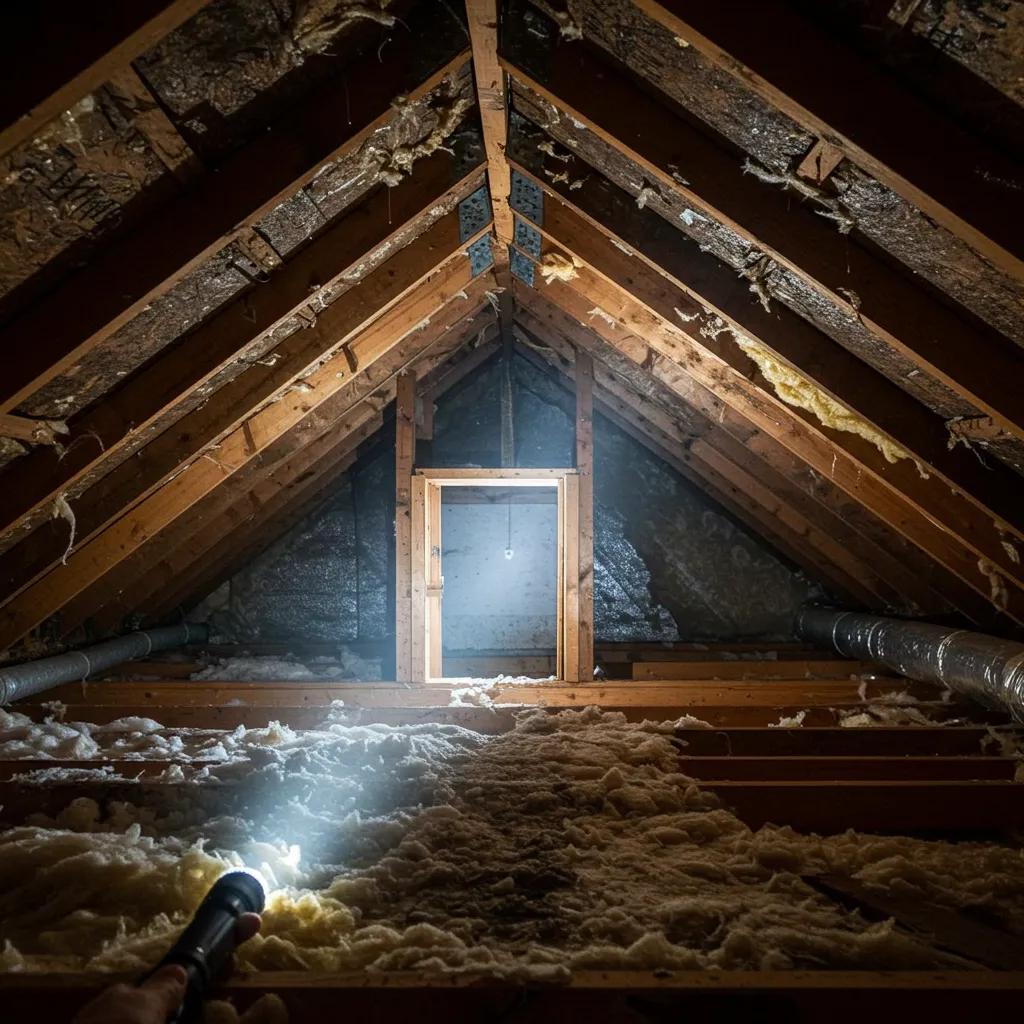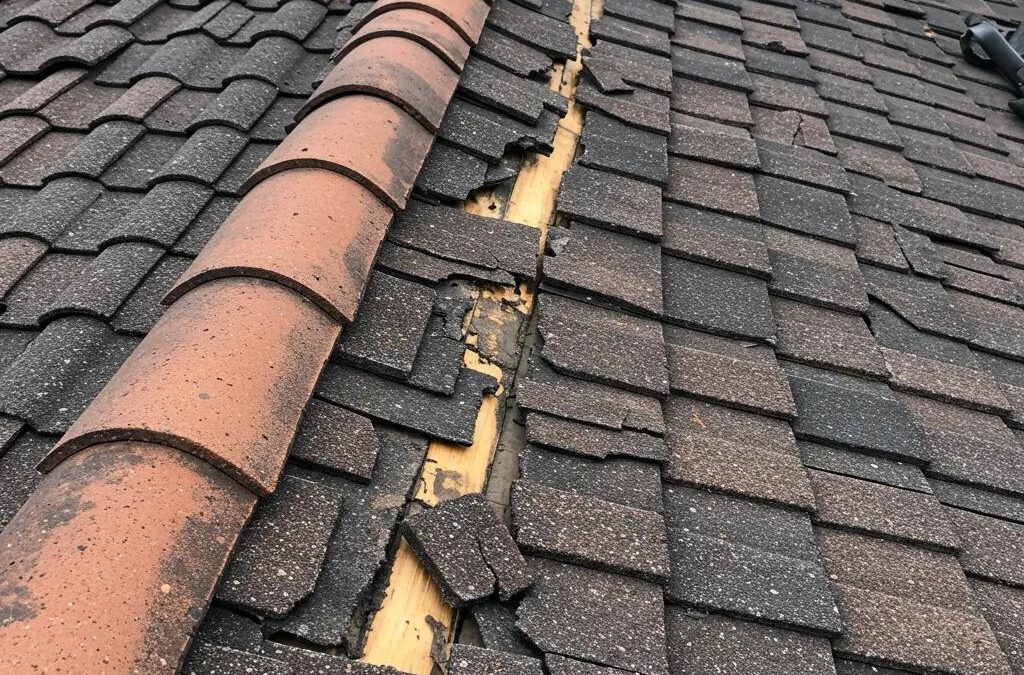Recognising Key Indicators of Roof Damage: Signs, Inspection, and Early Warning for Homeowners
Roof damage is any condition that reduces a roof’s ability to shed water, resist wind uplift, or protect the building envelope, and recognising it early saves money and prevents internal deterioration. This guide explains how to identify external and internal signs of roof damage, how Brisbane’s weather influences common failure modes, and a step-by-step roof inspection checklist homeowners can use to check for leaks. You will learn which symptoms — from cracked tiles and granule loss to attic moisture and flashing gaps — indicate urgent repair, which can be monitored, and when to call a professional. The article also maps observable signs to likely causes and practical responses, including temporary mitigation, maintenance tasks like gutter cleaning, and when professional roof repairs or restoration are needed. By the end of this guide you’ll have a repeatable inspection routine tailored to Brisbane’s subtropical climate and clear next steps for protecting your home.
What Are the Most Common Signs of Roof Damage?
Common signs of roof damage are observable problems that indicate compromised water protection, structural stress, or material degradation and they point to specific causes such as impact, ageing, or poor drainage. Exterior indicators include missing or displaced roofing elements, cracked tiles or dented metal, and sagging rooflines that suggest decking or rafter issues. Interior indicators are water stains, active attic leaks, damp insulation and mould growth, which often mean water has bypassed external defences. Identifying these signs early lets homeowners prioritise monitoring, perform temporary fixes, and document conditions for professionals or insurers before problems escalate.
This short reference table links common exterior and interior damage types to what to look for and immediate homeowner next steps.
This table helps map an observed symptom to a sensible immediate action and prepares homeowners for the next diagnostic steps, including a closer attic check described next.
How to Identify Exterior Roof Damage: Cracked Tiles, Missing Shingles, and Sagging Rooflines

Exterior damage shows up as displaced, broken or deformed roofing components and can usually be assessed from the ground using binoculars or by careful close inspection when safe. Cracked tiles typically reveal hairline fractures or missing pieces and are common on terracotta and concrete roofs after heavy storms or thermal cycling; Colorbond metal roofs show dents or torn edges where wind uplift has acted. Missing shingles or sheets leave dark patches and expose underlayment, increasing leak risk; small isolated losses can be monitored, while multiple missing elements demand professional attention. Sagging lines are a structural signal — when a fascia or ridge appears bowed, it often indicates compromised decking or rafter supports and should be inspected urgently by a professional; this observation leads directly to checking interior signs for leaks and structural distress.
What Interior Signs Indicate Roof Problems? Water Stains, Attic Leaks, and Ceiling Damage

Interior indications often reveal leaks that have bypassed the outer covering and tracked into the building fabric, and they are crucial for locating the breach and preventing secondary damage. Water stains on ceilings show as concentric brown patches or peeling paint; active dripping, soft spots in plasterboard, or fresh streaks indicate ongoing ingress and should be contained and documented. In attics, damp insulation, darkened timber, mould growth and musty odours point to chronic moisture entry or poor ventilation; compressed or wet insulation also reduces thermal performance and indicates immediate remediation needs. Tracing leaks requires photographing stains, checking the attic underside of the roof deck for daylight, and following the leak path toward roof penetrations or damaged flashing, which sets up the exterior inspection sequence below.
How Do Weather Conditions in Brisbane Affect Roof Damage?
Brisbane’s subtropical climate — with strong sunlight, high humidity and an active storm season — accelerates typical roof failure modes by combining UV degradation, moisture-driven biological growth, and storm-related mechanical damage. UV and heat speed up material ageing, causing brittle sealants and increased granule loss on shingle surfaces, while high humidity and regular rainfall promote moss and algae that retain moisture against tiles and metal. Intense storms and high winds can displace tiles, tear metal sheeting and loosen flashing; coastal suburbs may also experience salt-laden air that increases corrosion risk on metal components. Understanding these local drivers helps homeowners time inspections effectively and target maintenance where Brisbane’s climate creates the greatest long-term risk.
What Are the Effects of Storms, Wind, and Hail on Roof Integrity?
Acute weather events can cause mechanical damage such as displaced tiles, punctured membranes and dented metal, and rapid post-storm inspection is important for safety and claims documentation. After wind events look for lifted or missing tiles and torn flashings that allow water entry; hail commonly leaves pockmarks on metal roofs and broken tile fragments that may not leak immediately but shorten lifespan. Homeowners should prioritise safety, photograph damage from ground level, collect loose debris for records, and avoid walking on wet or unstable roofing; this documentation supports insurance and repairs and transitions into targeted maintenance like flashing checks. These post-event tasks set the scene for slower climate-driven damage such as granule loss and corrosion, which develop over time.
How Does Brisbane’s Tropical Climate Cause Common Roof Damage?
Brisbane’s combination of strong UV, humidity and seasonal rainfall leads to slow-developing issues such as granule loss from asphalt products, algae or moss colonisation on shaded tiles, and gradual corrosion of metal flashings. UV radiation breaks down polymeric binders and sealants, reducing flexibility and causing micro-cracks around penetrations, while humid conditions trap moisture that encourages biological growth that retains water next to roof substrates. Coastal exposure increases the risk of oxidisation on Colorbond and metal trims where protective coatings have degraded, and persistent moisture under moss accelerates tile breakage. Recognising these climate-linked processes enables targeted prevention like timely gutter cleaning and resealing penetrations before they progress to larger repairs.
How Can Homeowners Perform a Roof Inspection Checklist?
A homeowner roof inspection is a systematic set of exterior and interior checks focused on safety, documentation and triage so you can spot problems early and decide whether to monitor, perform simple maintenance, or call a professional. Begin with tools and safety measures, perform a ground-level exterior survey followed by a controlled close inspection if safe, and finish with an attic and ceiling check to triangulate any leaks. Use binoculars, a torch, a sturdy ladder, personal protective equipment and a camera to document defects; if you are uncomfortable with heights or storm damage, request a professional inspection instead. The step-by-step approach below is designed for Brisbane roofs and emphasises checking gutters for granules and blockages after heavy rain and photographing damaged flashings or missing tiles for future reference.
- Prepare and document: Gather binoculars, camera, torch, ladder and PPE; note recent weather events and take pre-inspection photos.
- Ground-level exterior scan: Walk the property perimeter and use binoculars to inspect roof planes, ridges and gutters for visible defects.
- Gutter and downpipe check: Clear small debris safely, inspect for granules and blockages, and note standing water or rust that indicates overflow.
- Close inspection (if safe): From a stable ladder check flashings, seals around vents and chimneys, and any displaced tiles or dented metal.
- Attic and ceiling check: Inspect insulation, roof decking for damp spots, and use a torch to locate daylight gaps or mould growth.
The numbered checklist helps homeowners perform ordered, documented inspections and leads into a practical tools table for each step.
Introductory table: tools mapped to actions help homeowners prepare and perform each inspection task efficiently.
What Are the Step-by-Step Exterior Inspection Tasks for Brisbane Roofs?
Exterior inspection tasks focus on gutters, tiles or metal sheets, flashings and roof penetrations and aim to capture climate-specific signs like granule accumulation after heavy rain or algae on shaded tiles. Start from the ground-level scan, then inspect gutters for trapped debris and granules that indicate surface wear; clogged gutters increase water contact at eaves and promote rot. From a ladder, check that flashings around chimneys, vents and skylights are secure and sealing is intact; look for gaps, rust or sealant cracks that often develop in Brisbane from UV and humidity stress. Photograph any damage for records and compare to past inspections to identify progressive deterioration; these exterior findings should be correlated with attic checks described next.
How to Spot Interior Roof Damage During an Attic and Ceiling Check?
Interior inspections reveal water entry that may not yet show on the exterior and should include ceiling lookovers and attic access where safe, with a focus on insulation, decking and ventilation. In the attic inspect insulation for wet, compressed areas, check timber for dark staining or soft spots and use a torch to find daylight penetrating the deck, which pinpoints holes or missing underlayment. Smell for musty odours and look for mould growth on timbers and insulation, which signals active or chronic moisture and may indicate poor ventilation as well as leaks. Findings inside the roof should be photographed and dated, then matched to exterior suspect areas — this triangulation narrows likely leak sources and sets priorities for professional interventions when needed.
When Should You Call a Professional for Roof Repairs or Restoration?
Call a professional when signs indicate immediate safety risk, widespread structural failure, or water ingress that is active and progressing, because these conditions require trained assessment, scaffolding or specialised repair methods. Red-flag indicators include active large-area leaks, significant sagging or decking collapse, extensive tile or sheet loss after storms, and visible structural movement; these situations demand prompt professional mitigation to prevent collapse or severe internal damage. Professionals provide thorough inspections, effective repairs such as flashing replacement or membrane patching, and documentation for insurance, while also advising whether restoration or full replacement is the long-term solution. Understanding the difference between monitorable defects and urgent risks helps homeowners decide when to pause DIY measures and engage certified trades.
This table guides homeowners from symptom to action and helps prioritise emergency responses before longer-term restoration decisions are made. After triage, homeowners often need an on-site estimate and documented inspection.
Roofing Specialist offers free roof inspections and free quotes to help Brisbane homeowners quickly determine whether repairs, restoration or full replacement are required, and to document issues for insurance. The company provides repair and restoration services as relevant to the red-flag conditions described above and can perform temporary weatherproofing before permanent repairs; this professional assistance complements homeowner triage while preserving safety and supporting claims documentation. Understanding when to escalate to a professional reduces the risk of small, monitorable problems turning into emergency repairs.
What Roof Damage Warrants Immediate Professional Attention?
Immediate attention is required when leaks are active and causing internal damage, when roof structure shows sagging or movement, and after storm events that leave widespread detritus or unstable roof elements.
Active, gushing leaks or rapidly expanding ceiling stains indicate a failing barrier and need urgent covering or tarping to protect interiors; professionals can provide safe temporary covers and schedule permanent repair. Visible structural sagging implies load-bearing elements may be compromised and should be assessed immediately to avoid collapse; do not walk on or store items under sagging areas. Widespread tile loss or large sections of missing metal after storms are both a safety and water-entry risk that merits emergency professional intervention; these red flags then guide restoration or replacement choices discussed next.
How Do Roof Repairs and Restorations Address Specific Damage Types?
Repairs focus on targeted remedies such as replacing cracked tiles, resealing or refastening flashings, and patching membranes, while restoration often involves a broader scope: cleaning, resealing, re-bedding tiles and re-coating metal roofs to extend service life. Tile replacement and re-bedding correct localized breakage and restore watertightness; flashing repair and resealing address common leak locations around penetrations. For roofs with widespread ageing but intact structure, restoration can renew protective coatings and replace worn seals, delaying full replacement; conversely, when decking is rotten or structural elements are compromised, replacement becomes the safer long-term choice. After professionals assess the scope, they will recommend repair, restoration or replacement based on structural condition, material life and cost-benefit factors.
What Are the Early Warning Signs of Roof Problems Every Homeowner Should Know?
Early warning signs are small indicators such as granule loss in gutters, isolated moss patches, or tiny flashing gaps that often precede leaks and accelerate material failure if ignored. Recognising these micro-signs during routine maintenance like gutter cleaning or after storms allows homeowners to schedule minor repairs that prevent escalation to decking rot or full replacement. Regular monitoring of these subtle cues, combined with seasonal checks timed to Brisbane’s wet and storm seasons, reduces lifecycle costs and improves roof longevity. The short table below links early signs to what they suggest and what to do next.
Early detection and small repairs reduce long-term costs by stopping progressive water entry and material breakdown, which is why timely professional support is often cost-effective.
Promptly addressing early signs saves money: minor interventions such as resealing flashings or replacing a handful of tiles are typically far less costly than full replacement after decking failure. For homeowners seeking professional assistance, Roofing Specialist provides roof repairs, roof restoration and roof replacement services to address these early signs before they escalate. Engaging a professional for preventative work after detecting micro-signs in this table reduces the risk of larger structural problems and helps maintain the roof’s expected service life.
How to Recognise Granule Loss, Moss Growth, and Flashing Damage Early
Granule loss appears as gritty deposits in gutters or dark patches on exposed shingle edges and indicates surface erosion that will shorten the shingle’s effective life, and it is often most apparent after heavy rain. Moss and algae start as small green or black patches in shaded valleys or near gutters; they trap moisture and can lift tiles or create micro-voids where water sits, so early removal prevents prolonged moisture exposure. Flashing damage begins as hairline sealant cracks or small separations at chimneys, vents and hips which may not leak immediately but permit wind-driven rain; resealing or professional flashing replacement at this stage is far preferable to repairing interior water damage later. Spotting these indicators during routine gutter clearing or visual roof scans enables economical, timely intervention.
Why Is Prompt Detection Important to Prevent Costly Roof Replacement?
Prompt detection slows the cascade from surface wear to underlayment failure, decking rot and ultimately full roof replacement, because early repairs protect core structural elements and preserve the roof’s waterproof layers. Small defects like isolated cracked tiles, granule loss, or flashing gaps allow moisture ingress that over months or years can degrade timber decking and insulation, pushing a repair bill into a replacement-level expense. A simple cost illustration: addressing a flashing failure early typically involves targeted labour and materials, while delayed action can require large-scale stripping and replacement of battens and underlayment. Regular checks and quick professional engagement therefore offer clear lifecycle savings and reduce the chance of emergency roof works.
How Does Regular Roof Maintenance Prevent and Detect Damage?
Regular maintenance prevents damage by removing moisture-retaining debris, maintaining seals and coatings, and allowing early detection of small defects before they spread into structural problems; it also creates a documented history that supports warranty and insurance claims. Scheduled tasks such as gutter cleaning, vegetation control, resealing flashings and checking ventilation keep water moving away from vulnerable edges and reduce material stress from trapped moisture. For Brisbane homes, inspections timed pre- and post-storm season detect climate-driven damage early, and professional maintenance can include restoration that extends the working life of Colorbond and tiled roofs. Consistent maintenance also reveals subtle trends like gradual granule loss so homeowners can plan restoration before replacement is required.
Gutter maintenance is especially important because blocked gutters concentrate water at eaves and can cause moisture to undercut roof edges, leading to rot and internal moisture problems if left unaddressed.
What Role Does Gutter Cleaning Play in Avoiding Roof Damage?
Gutter cleaning prevents water backing up under eaves, stops debris from holding moisture against roofing materials, and reveals signs such as granules that indicate shingle wear; it is therefore both preventive and diagnostic. When gutters overflow the resulting concentrated water can seep behind fascia and into eaves, promoting rot and degrading edge flashings, so keeping gutters clear reduces that risk. During cleaning inspect collected debris for shingle granules, displaced tile fragments or corrosion flakes — these clues point to upstream roof wear. Regular pre-wet-season and post-leaf-fall gutter checks reduce the chance of water-related structural damage and make other inspection tasks more effective.
How Often Should Brisbane Homeowners Inspect Their Roofs for Damage?
Brisbane homeowners should perform baseline inspections at least twice yearly — once before the storm/wet season and once after — with additional checks after major storms, high winds or hail events to catch acute damage quickly. Coastal properties and older roofs should increase frequency because salt air and material age accelerate wear; in those cases quarterly visual checks or professional inspections are prudent. If previous repairs exist, schedule follow-up inspections sooner to confirm the integrity of remedial work and ensure warranties remain valid. Adopting a regular cadence and documenting each check means small issues are more likely to be caught early, reducing the probability of costly emergency repairs or replacement.
Roofing Specialist provides free roof inspections and free quotes, holds industry memberships such as HIA and MPA, offers a 10-year written guarantee on repairs and restorations, and maintains full insurance coverage (including up to $10 million public liability), which can give homeowners additional assurance when moving from DIY inspection to professional repair or restoration.
- Regular inspections: Twice-yearly baseline checks and post-storm reviews reduce escalation risk.
- Preventive cleaning and resealing: Gutter cleaning and flashing resealing stop moisture entry points.
- Professional maintenance: Scheduled restoration and certified repairs extend roof life and support warranties.

